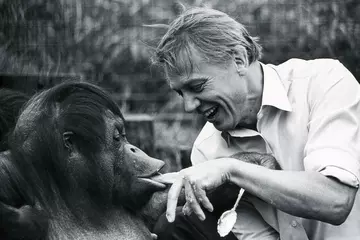
London Zoo releases online gallery of archive images to mark this year’s Winnie-the-Pooh Day – as historic zoo renews fundraising appeal during lockdown
London Zoo will mark Winnie-the-Pooh Day this Monday (18 January) with the release of rare archive images taken during its almost 200-year history – as the historic zoo renews its urgent call for public support to feed and care for its 18,000 animals during the nationwide lockdown.
The fascinating online gallery gives a heart-warming glimpse into past life at ZSL’s world-famous zoo and includes an heartwarming image of the inspiration behind the classic children’s story – a Canadian black bear called Winnie, much loved by author A. A Milne's son, Christopher Robin, who often visited her at the zoo.
The images - including that of Winnie with Christopher - are a keen reminder of the role the zoo has played in both science and culture in the last two centuries, and of the need to safeguard its future, following the devastating impact of the coronavirus pandemic.
London Zoo's place in the country's cultural history
London Zoo’s Chief Operating Officer, Kathryn England, said: “Winnie-the-Pooh Day is not just a celebration of the classic childhood story – to us it’s a mark of the important place that London Zoo has in the country’s cultural history: it’s where Darwin and Huxley developed much of their thinking, where Sir David Attenborough first began working as a wildlife TV presenter and where millions have been inspired with a love for wildlife.

“2020 was the most challenging year in our 192-year history, costing the zoo millions of pounds in lost revenue - funds which help us to care for and feed the animals, and carry out ZSL’s vital science and conservation work – and we expect this current lockdown to cost us a further £1.8million.
“Fans of the famous ‘silly old bear’ can usually flock to London Zoo on Winnie-the-Pooh Day, often bringing their favourite cuddly characters to visit Pooh’s real-life friends - cheery pigs, friendly kangaroos, wise owls and playful tiggers - and posing with the much-loved Winnie statue at the heart of the zoo, giving her nose a traditional rub for good luck.
Winnie-the-Pooh Day
“But whilst they currently can’t visit, we’re hoping the public will continue to support us through this difficult time - as Sir David Attenborough said when we launched our fundraising campaign during the first lockdown, London Zoo was the first scientific zoo in the country and has been at the forefront of zoological advances ever since - with our doors closed once again we urgently need support to continue our vital work.”
First published on 14 October 1926, Winnie-the-Pooh was named after London Zoo’s female black bear, who arrived on 9 December 1914 and was the mascot of a Canadian regiment, the Second Canadian Infantry Brigade, who were in training on Salisbury Plain - she had been purchased earlier that year for $20 by Lieutenant Harry Colebourn, from a hunter in White River, Ontario, who named her Winnie after his hometown of Winnipeg.
Colebourn intended to eventually take Winnie back to Canada with him and would often visit her at the Zoo while on leave - but after seeing how loved she was by both visitors and staff, decided to leave her in the full-time care of the zoo’s keepers once the war ended. Milne decided to name his fictional character, Pooh Bear, after Winnie, and the rest, as they say, is history.

Reliant on income from ticket sales to care for the animals and fund their global conservation efforts, months of enforced closures have put ZSL’s charity zoos under huge financial pressure. Vets and zookeepers will continue to provide the highest level of care for their animals, working throughout the lockdown. ZSL, the international conservation charity behind the Zoos, is calling on the public to help ensure they remain open by donating to ZSL at www.zsl.org/donate
